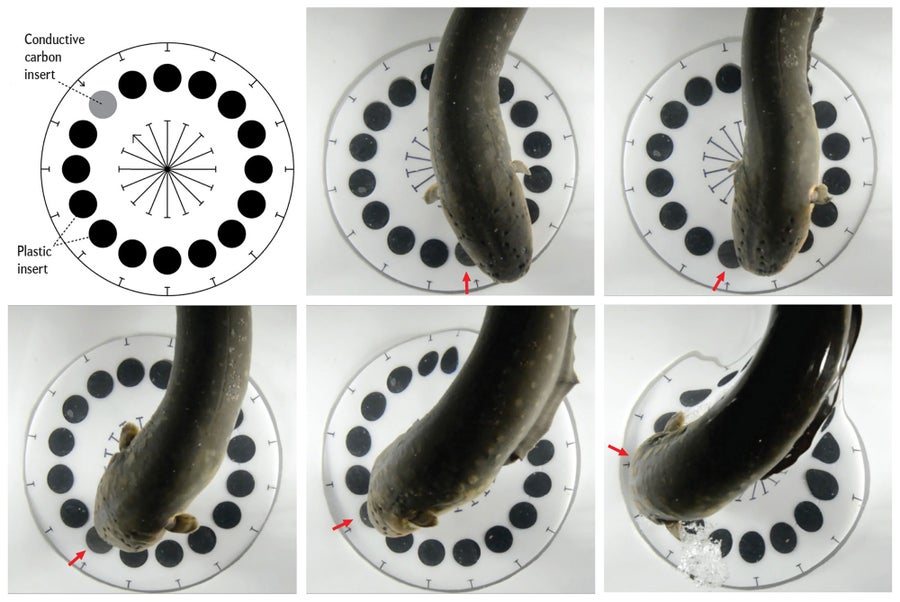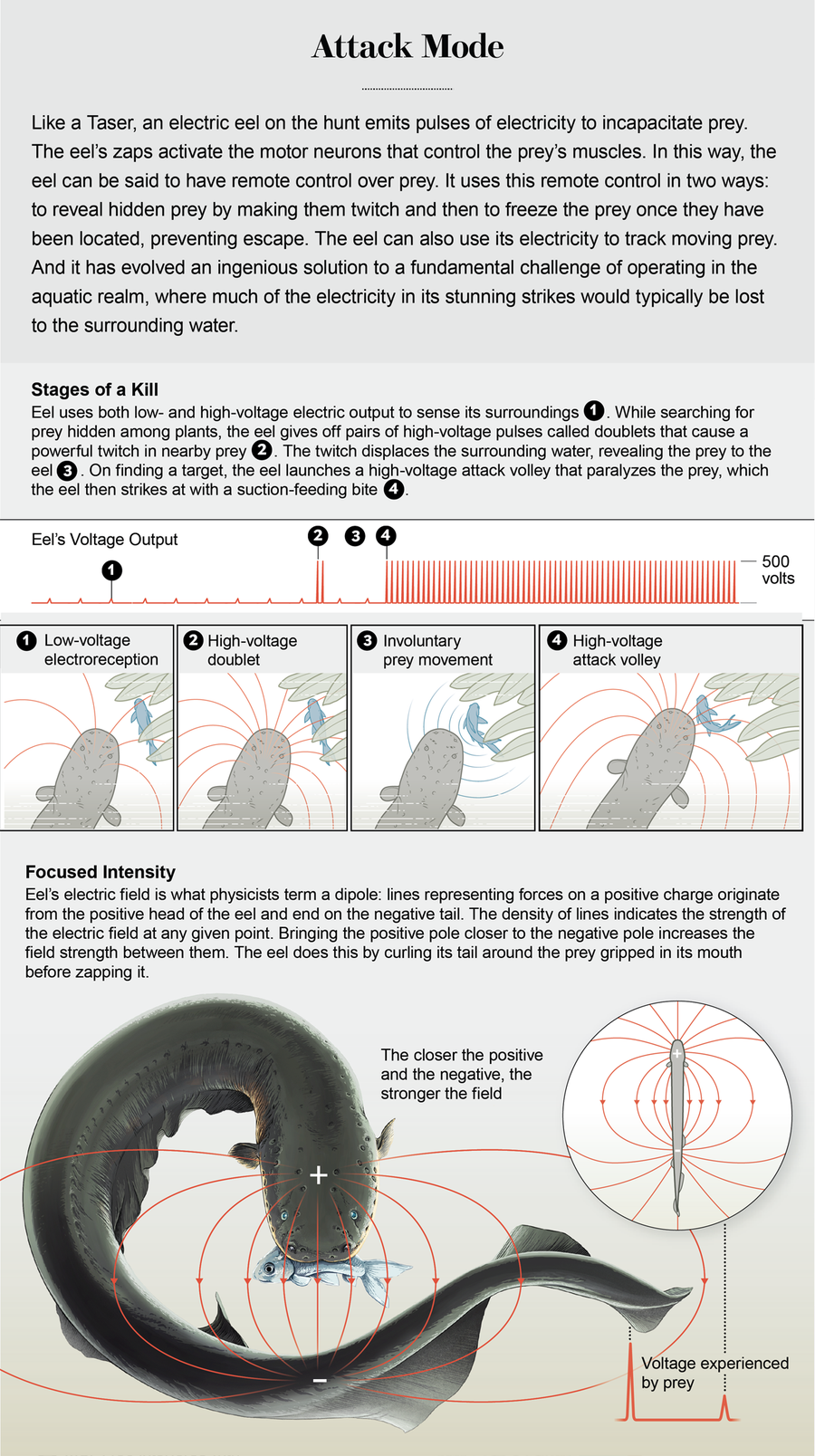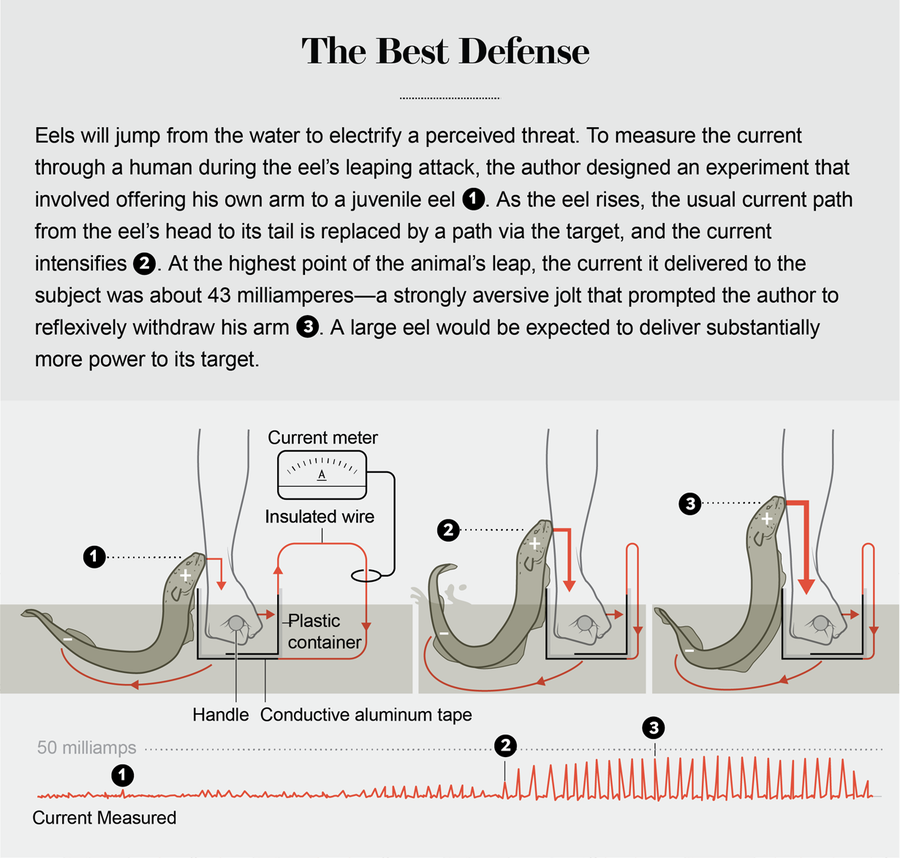It’s no secret that electric eels stun their prey—accounts of such occurrences date back centuries. But unless you work security on the starship Enterprise, “stun” is a vague term. What really happens when these creatures attack? Until recently, biologists knew surprisingly little about the electric eel’s superpower. I was not planning to study this phenomenon, and I certainly never imagined I would offer an eel my arm in the name of science, as I eventually did. But as a professor of biological sciences at Vanderbilt University, I teach about electric fish, and when I brought some eels to my laboratory so I could obtain new photographs and slow-motion movies to liven up my lecture, I saw something so strange that I had to drop everything else to investigate.
When an eel attacked a prey fish with high voltage, all the nearby fish in the tank became completely immobile in only three milliseconds. It was as if they had been turned into little statues; they just floated stock-still in the water. At first, I wondered if they had simply been killed. But if the eel missed its target and turned off the high voltage, the fish “unfroze” and took off at full speed. The eel’s effect was temporary. I was hooked; I had to know how the eel’s electric attack worked.
The most obvious analogy that came to mind was a law-enforcement Taser, which causes neuromuscular incapacitation by interfering with the nervous system’s ability to control muscles. Tasers deliver electricity along wires in short, high-voltage pulses at a rate of 19 pulses a second. Electric eels do not need wires, because the water allows current to flow, as happens when a hair dryer falls into a bathtub. But otherwise, the eel’s output is reminiscent of a Taser’s: it comes in brief pulses, each lasting only about two milliseconds. Eels can give off more than 400 pulses per second during an attack volley, however—a much higher rate than the law-enforcement devices. Could electric eels be souped-up, swimming Tasers?
On supporting science journalism
If you're enjoying this article, consider supporting our award-winning journalism by subscribing. By purchasing a subscription you are helping to ensure the future of impactful stories about the discoveries and ideas shaping our world today.
With this question in mind, I set out on what would become a three-year mission to unravel the mechanism of the eel’s attack and the effects of its shocks on both prey and would-be predators. I was surprised at every turn by the eel’s sophisticated use of electricity and reminded that humankind’s inventions don’t hold a candle to nature’s.
Shock value
You might be surprised to learn the electric eel is not a true eel but rather belongs to a family of fish known as the Gymnotidae that live in South America. The other members of this group give off very weak electric discharges that they use to sense their surroundings and to communicate. The electric eel has amped up its power over the course of evolution. It can generate a charge of up to 600 volts, thanks to the electric organ that spans nearly the length of their body (the animals can reach eight feet in length and weigh more than 40 pounds). The organ is composed of thousands of special disk-shaped cells called electrocytes that work like batteries to discharge electricity.
To investigate the possibility that the electric eel operates like a Taser to incapacitate its prey, I needed to observe the animal in hunting mode. So I devised an experiment that took advantage of the eel’s insatiable appetite for earthworms. First, I placed a dead fish that still had working nerves and muscles in the water with the eel (but separated by an electrically permeable barrier) and attached it with a string to a device for measuring muscle contractions. Then I fed the eel earthworms, which it happily shocked and ate. This setup allowed me to conduct a series of tests on the fish muscle responses to the high-voltage pulses emanating from the hunting eel.

Tracking system: The eel can track prey and other conductors using high-voltage electroreception. In experiments with a spinning disk bearing one conductive insert and multiple nonconductive inserts, the eel singled out the conductive insert with remarkable accuracy. Credit: Kenneth C. Catania
The volleys of high-voltage pulses from the eel caused massive muscle contractions in the fish that started three milliseconds after the electric attack began—exactly the same amount of time that passed before the fish were seen to stop moving in the slow-motion movies. Apparently eels invented the Taser long before humans. But the experiments showed much more. Eels do not activate fish muscles directly. Instead their zaps activate the nerves that lead to the fish muscles. Each high-voltage pulse from an eel generates an action potential, or nerve impulse, in the fish’s motor nerves.
This finding is remarkable when you consider that the eel’s electric organ is a modified muscle activated by the animal’s own motor nerves. The motor nerves are, in turn, activated by neurons in its brain. For each high-voltage pulse, the flow of command signals starts in the eel’s brain and travels to its motor neurons, which then activate the electric organ. From there the signal passes through the water to trigger the motor neurons, and then muscles, in nearby fish. In other words, the eel immobilizes its prey using a form of high-fidelity remote control.
Intriguingly, this insight suggests the eel’s electric output may have been shaped in part by what happens to the muscles of its prey. With this finding in mind, I began considering the eel’s high-voltage volley with a new perspective. I was especially intrigued by reports from a previous investigator, Richard Bauer, who in 1979 showed that hunting electric eels often pause to give off pairs of high-voltage pulses, each separated by two milliseconds. These paired pulses are called doublets, and all the eels in my lab exhibited the same behavior. What, I wondered, are doublets for?
A little research into muscle physiology revealed that doublets—which can also be described as pairs of action potentials—sent from motor neurons to muscles are the best way to generate maximal muscle tension. Accordingly, my experiments showed that eel doublets cause a brief, massive, whole-body twitch in nearby prey, in contrast to the volleys, which cause sustained paralysis. The twitch, in turn, produces a strong water displacement—essentially an underwater sound. Given the eel’s exquisite sensitivity to the slightest water movement, an interesting possibility comes to mind. Could doublets be the eel’s way of asking, “Are you alive?” After all, wild eels hunt at night in the Amazon, surrounded by a vast diversity of hidden prey—things that are far harder to find than worms and goldfish dropped into a tank.
Supporting this idea: when eels in my lab hunted novel prey, such as crayfish, or prey hidden among plants in the tank, they often gave off doublets while searching and attacked after the prey twitched, as if the prey’s movement had tipped them off. These were telling observations, but to provide more direct evidence, I attached the dead fish to an electric stimulator that could be triggered by either me or the eel’s doublets. I then placed the wired fish in a ziplock bag so the eel’s own doublets would have no effect on it. This setup allowed me to control when the fish’s muscles twitched. Sure enough, the eels never followed a doublet with an attack unless the fish twitched. The work showed that the eels were, in fact, attacking in response to doublet-generated fish movements.
Thus, the electric eel has two modes of remote control, which together make for one of the most insidious hunting tactics in the animal kingdom: it can unmask hidden prey by making them move, and it can freeze moving prey once they have been discovered.

Credit: Matthew Twombly; Sources: “Electric Eels Concentrate Their Electric Field to Induce Involuntary Fatigue in Struggling Prey,” by Kenneth C. Catania, in Current Biology, Vol. 25, No. 22; November 16, 2015, and “The Shocking Predatory Strike of the Electric Eel,” by Kenneth Catania, in Science, Vol. 346; December 5, 2014
Doubling down
Remotely controlling another animal is pretty cool, but it is not the eel’s only trick. The creature also has an ingenious solution to a fundamental problem with its electric output. Unlike superheroes or wizards who can aim lightning bolts, every time the eel gives off a high-voltage pulse, the electricity is distributed throughout the surrounding water. As a result, only a tiny fraction of the eel’s prodigious power is transmitted to prey. English physicist and chemist Michael Faraday, who coincidently worked with electric eels in 1838, gave us a convenient way to visualize the problem: The eel’s electric field is a so-called dipole, with lines representing forces on a positive charge emanating from the positive head of the eel and ending on the negative tail. The density of lines reflects the strength of the electric field at any given point; it is strongest at the poles and falls off in strength rapidly with distance. In introductory physics, you learn that bringing a negative pole close to the positive pole greatly increases the field strength in between. Eels have apparently taken physics because they use this move on difficult, struggling prey. The eel holds the victim firmly in its jaws and curls its tail (the negative pole) around the animal before delivering a series of high-voltage volleys.
To measure the effect of the eel’s maneuver, I designed an eel “chew toy”—a pair of recording electrodes on a plastic holder inside a dead fish. The eels grabbed the apparatus, and I shook the attaching wires to simulate struggling. The eels obliged, curling around and shocking the electrodes. As expected, the field strength more than doubled. It is a great strategy, allowing the eel to concentrate its otherwise fixed power output on a target, like focusing the fixed power of a flashlight to a single bright spot.
What happened to prey was predictable yet awe-inspiring. Subsequent experiments showed that the eel’s amped-up attack causes muscle contractions at abnormally high rates, totally and utterly exhausting prey in just a few seconds. It is the electric analogue of a neurotoxin, allowing the eel to capture and subdue otherwise dangerous animals, such as large, clawed crayfish.
More than a weapon
During my studies of the eel’s hunting behavior, I noticed something that made me wonder whether the shocks might function as more than just a weapon. Typically three things happen when electric eels go in for the kill. First, they give off a full volley of high-voltage pulses, then they rapidly strike at the prey and suck it into their mouth. But in my experiments, when the dead fish was made to twitch in the insulated plastic bag, the eel’s attack was always cut short. The eel gave off the high-voltage volley and struck toward the fish but missed and aborted the attack without the final suction-feeding bite. Why?
I had assumed the eels’ strike was ballistic—a preplanned event that takes place without sensory feedback. But now it occurred to me that the animals might use high-voltage pulses as a tracking system. This would explain why they overlooked prey insulated in plastic. Electric eels evolved from weakly electric fish that use electricity to probe their surroundings, and they have retained the weak, low-voltage electric output used for sensing. Why not use the high voltage for sensing as well? I decided to put this possibility to a test.
I took advantage of the conductive properties of prey and the eel’s aggressive hunting behavior. Submerged animals tend to be more conductive than water, so an electric eel is especially interested in conductors because they have the “signature” of living things. Keep in mind, though, that the eel can and does detect conductors with its low-voltage system, which is always active until the predator switches to high voltage during an attack. To specifically test for high-voltage electroreception, I needed to examine the eel’s behavior in slow motion during the strikes, when the low-voltage system was off and only the high-voltage one was active.
The first simple experiment was to add a rod made of carbon, an inert conductor, to the aquarium near the twitching fish in the ziplock bag. Once again, the eel attacked when it detected the water movement from the twitch and struck toward the bag with the insulated fish. But this time, the eel changed course midway and tried to eat the carbon rod with a full-on suction-feeding strike. The eel seemed to interpret the carbon rod as the fish—as one would expect if it was using the high-voltage pulses to track prey.
It was a great start, but I needed more evidence. I developed additional tests with carbon rods and multiple plastic rods to control for vision. Each time, the eels attacked the carbon conductor while giving off high-voltage volleys. The ultimate test was to present the eels with a rapidly spinning disk that had a single small conductor embedded in its surface, along with a series of identical-looking nonconductive control objects. The eels’ performance was incredible: they could track and attack the conductor during the high-voltage volley with a speed and accuracy unheard of for animals that employ active electroreception. There was no doubt—they use high voltage simultaneously as a weapon and as part of a sensory system to track prey. My respect for electric eels was growing daily, which was fortunate because their next trick was directed at me.
A stunning defense
In March 1800 Prussian naturalist Alexander von Humboldt hired villagers in the Amazon to collect some electric eels for experiments. The result became an epic tale. They decided to fish for the eels using horses. They rounded up 30 wild horses and mules and forced them into a shallow pool full of eels, which emerged from the mud to attack the horses, shocking them repeatedly. The villagers yelled and waved branches to corral the terrified horses in the pool until the eels were spent and could be collected safely. Two horses died in the mayhem; others stumbled from the pool and collapsed on the bank. Humboldt published an account of the spectacle in 1807, and the story helped to propel him to fame. But some later scholars were skeptical about Humboldt’s claims. Why would eels go on the offensive against large animals that they could not eat, risking injury in the process? No further instances of such behavior were reported for more than 200 years, until I chose the wrong net to catch a large eel in my lab.
As a rule, electric eels do not leap out of their aquarium. But there is an exception: if you approach a cornered eel with a large conductor that is sticking out of the water, it will often respond with an explosive attack. I discovered this literally shocking behavior when I tried to transfer a large eel to a new aquarium using a net with a metal rim and handle. In an instant, the eel turned and leaped from the water with its lower jaw pressed against the metal handle while it gave off a long volley of high-voltage pulses (fortunately, I was wearing a protective rubber glove). It is a daunting defensive behavior exhibited by all the eels I have tested.
As I investigated the electric consequences of the eel’s leap and accounts of Humboldt’s adventures, many pieces of the biological and historical puzzle fell into place. If eels interpret small conductors as edible prey, it follows that an approaching, partly submerged large conductor would be interpreted as a large threatening animal—perhaps a predatory cat or crocodilian. Why not swim away? During the dry season in the Amazon, electric eels are often trapped in small pools, where they are at risk of predation—exactly the situation reported for Humboldt’s eels. Add to this scenario the fact that eels cannot “aim” their electricity when submerged, and you have the recipe for evolving an astonishing defense strategy.
So is Humboldt’s dramatic story true? Although he does not provide much detail in his famous account, I was able to find a little-known illustration of the event, which appeared decades later in a book authored by Robert Schomburgk, a British explorer and acquaintance of Humboldt’s. The central figure is a horse being shocked by an eel that has jumped out of the water to press its lower jaw against the horse’s chest. It is the spitting image of the leaping eels from my lab. As far as I am concerned, if Humboldt reported discovering dinosaurs in the Amazon, I would want to check it out.
Building buzz
Some things are hard to explain to the university’s purchasing department, and severed zombie arms fall squarely in this category. So I thought it best to use my own money when I needed fake arms for another set of experiments with the eels aimed at further elucidating their leaping behavior. After scrubbing the fake blood off the arms, I filled them with light-emitting diodes strategically placed to mimic nerve tracts and presented them to the eels. Bringing an arm close to an eel resulted in a compelling demonstration of the leaping defense. The lights flashed brighter as the eel rose farther out of the water while shocking the arm. But exactly how and why did this happen?

Credit: Matthew Twombly; Sources: “Power Transfer to a Human during an Electric Eel’s Shocking Leap,” by Kenneth C. Catania, in Current Biology, Vol. 27, No. 18; September 25, 2017
Getting the answers to these questions required working out the so-called equivalent circuit and then determining the voltage, or electromotive force, of the eel’s electric organ. I would also need to calculate how much the materials in the circuit reduce the flow of electric current through it—a property known as resistance. So I designed experiments to measure each variable in succession, starting with the eel’s electric organ. At slightly more than three feet long, the largest eel in my lab had an electric potential of 382 volts and an internal resistance of only 450 ohms, allowing for currents of nearly one ampere if there were no other resistances. That is quite an electric punch—far greater than a Taser’s.
When an eel emerges from the water, pressing its lower jaw against a target, the usual current path for electricity from the eel’s head to its tail is progressively shut down—because air is a poor conductor—and is replaced by a path through the target. Remarkably it is similar to a volume-control knob—the eel progressively turns up the volume in the target as it rises from the water. This observation explains how the behavior could have gradually evolved because each increment in height provides an advantage. But how efficient is the eel at turning up the volume?
When working out the details, I ran into the most basic of circuit problems: calculating the electric current in a circuit containing two resistors arranged side by side. It is a favorite challenge in circuit puzzles (that is, physics exams) because you cannot calculate the electric current in the circuit without knowing the value of both resistors. I was able to solve for one resistance—the path from the eel’s head to the water—by taking measurements from eels attacking metal plates connected to a voltmeter. The other resistance was the arm—the eel’s target. After collecting data for all the other variables, I could only guess at this last value: the complex resistance that developed between the eel’s jaw, a living target and the surrounding water.
It was hard to stop working on the circuit without the final answers. In addition, just as my first paper documenting the eel’s leaping attack was published in 2016, a video was posted to the Internet showing a very large eel leaping onto a surprised fisherman in South America (he was temporarily immobilized and then recovered, similar to the aftermath of being Tased). Suddenly the circuit I had been studying out of curiosity had real-world consequences.
There was nothing for it but to use my own arm to determine the last variable and test the predictions from all the previous measurements. I used a very small eel with an electromotive force of 198 volts and an internal resistance of 960 ohms. I built a device that measured the current through my arm during the eel’s attack, allowing me to finally solve the circuit. I can also report with conviction that eels are very efficient at turning up the volume of their attack.
I may have started this project thinking I would teach about electric eels, but in the end, it was the eels that taught me. It is the same lesson I relearn every time I investigate a new species: the animals are always far more interesting than I could possibly imagine, in ways I could never have predicted at the outset. It keeps me up at night—in a good way—to contemplate all we have yet to discover.

